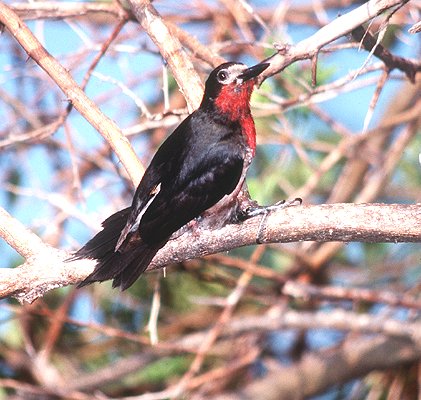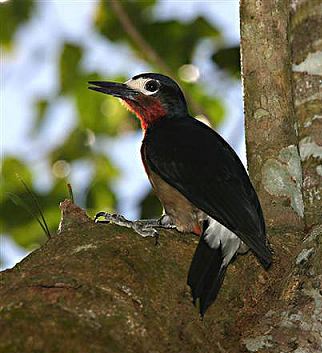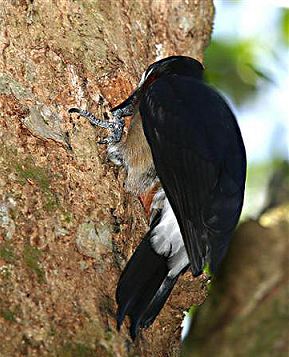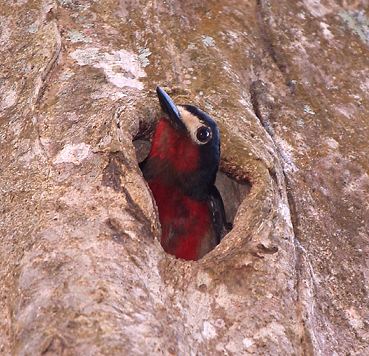|
Puerto Rican Woodpecker Melanerpes portoricensis Carpintero de Puerto Rico
|
 |
|
Photo: M. Oberle
|
|
Puerto Rican Woodpecker Melanerpes portoricensis Carpintero de Puerto Rico
|
 |
|
Photo: M. Oberle
|
|
IDENTIFICATION: Solid black upper parts, with a bright red throat and breast, and a white forehead. The lower abdomen and flanks are buffy colored. Its white rump patch is striking in flight. The female has less red below than the male. Length: 23-27 cm.; Average weight: about 70 g., with females being smaller than males. VOICE: Calls include a loud series of "wicka" notes. Makes a drumming sound by hammering on trees, but drums less often than North American woodpecker species. Audio (M. Oberle). HABITAT: Forests, shade coffee plantations, mangroves, palm groves, parks and gardens: wherever there are stands of trees. HABITS: Gleans insects from bark, and probes or drills holes in tree trunks and limbs for its favorite foods: beetle larvae, ants, earwigs, and other insects. The woodpecker has stiff tail feathers that help the bird brace itself to chisel into wood. It occasionally eats scorpions, lizards, and frogs, and 1/4 or more of its diet consists of berries and palm fruits. The smaller female is more likely than the male to forage on small branches in the canopy and is more likely to glean insects from plant surfaces or cracks, rather than peck holes for prey. Like other woodpeckers, the Puerto Rican Woodpecker has a barbed tongue and sticky saliva that help it remove insects from crevices and bored holes. The ligaments that control the tongue are so long that they are stored under the skin around the back of the skull. When flying, it gives several bursts of wing flaps, then pauses between bursts, producing an undulating flight path. Small groups will chatter in dead or sparsely-leafed trees like Cecropia. The Puerto Rican Woodpecker excavates a nest cavity in a tree, or occasionally a utility pole, and lays 4-6 white eggs. Sometimes it nests in loose colonies. The Woodpecker can be attracted to backyard suet feeders and will chase off grackles and other birds if they approach its food too closely. In conflicts at feeders, the Puerto Rican Woodpecker can be quite aggressive against Greater Antillean Grackles and White-winged Doves. The author has found feathers below his suet feeder where the woodpecker has attacked White-winged Doves. He once saw a male woodpecker perched on a branch adjacent to the feeder while he held a dangling White-winged Dove by the wing. In another encounter, a lone Greater Antillean Grackle was on a branch at the suet feeder when a male woodpecker flew in. The grackle and woodpecker faced off and then switched to branches on opposite sides of the feeder. Then the woodpecker lunged toward the grackle and grabbed it by the bill. He held it while the grackle dangled below the branch and flapped its wings for a few seconds before dropping and flying off (an identical episode occurred two months later). Later that morning, three grackles flew in, and the male woodpecker called persistently, warning off the grackles. In another incident, a woodpecker pair cooperatively fended off multiple grackles approaching the feeder from different directions. Only once had the author seen woodpeckers squabble at a feeder: a male grabbed a female by the wing and pushed her off the perch branch under the suet feeder. STATUS AND CONSERVATION: Common in forests and woodlots throughout Puerto Rico. Its nest cavities are used by other birds including the endemic Puerto Rican Flycatcher and the endangered Yellow-shouldered Blackbird. RANGE: The Puerto Rican Woodpecker is endemic to Puerto Rico and Vieques. It was formerly found on St. Thomas in the U.S. Virgin Islands. A regular location to find this species is around the parking lot at the El Portal visitor center in El Yunque. TAXONOMY: PICIDAE; Picinae |
 |
|
|
Photo: M. Oberle
|
 |
|
|
Photo: M. Oberle
|
 |
|
|
Photo: M. Oberle
|
 |
|
|
Photo: M. Oberle
|
 |
|
|
Photo: M. Oberle
|
 |
|
|
Photo: M. Oberle
|
 |
|
|
Photo: M. Oberle
|
 |
|
|
Photo: M. Oberle
|
 |
|
|
Photo: M. Oberle
|
 |
|
|
Photo: M. Oberle
|
 |
|
Photo: L. O. Nieves
|
 |
|
Photo: L. O. Nieves
|
 |
|
Photo: L. O. Nieves
|
 |
|
Photo: R. Rodríguez Mojica
|
 |
|
Photo: R. Rodríguez Mojica
|
 |
|
Woodcarving: Joel Soto
|
|
References Cruz, A. 1974. Distribution, probable evolution, and fossil record of West Indian Woodpeckers (Family Picidae). Carib. J. Sci. 14:183-188. Cruz, A. 1980. Avian feeding assemblages in Puerto Rico. Carib. J. Sci. 15:21-27. Cruz, A. 1987. Avian community organization in a mahogany plantation on a Neotropical island. Carib. J. Sci. 23:286-296. del Hoyo, J., A. Elliott, and J. Sargatal, eds. 2002. Handbook of Birds of the World, Vol. 7. Jacamars to woodpeckers. Lynx Edicions, Barcelona. Raffaele, H.A. 1989. A guide to the birds of Puerto Rico and the Virgin Islands. Princeton. Raffaele, H.A. 1989. Una guía a las aves de Puerto Rico y las Islas Vírgenes. Publishing Resources, Inc., Santurce, PR. Raffaele, H.A., J.W. Wiley, O.H. Garrido, A.R. Keith, and J.I. Raffaele. 1998. Guide to the birds of the West Indies. Princeton. Recher, H.F. and J. T. Recher. 1966. A contribution to the knowledge of the avifauna of the Sierra de Luquillo, Puerto Rico. Carib. J. Sci. 6:151-161. Saliva, J.E. 1994. Vieques y su fauna: Vieques wildlife manual. U.S. Fish & Wildlife Service, Boquerón, PR. Winkler H., D.A. Christie, and D. Nurney. 1995. Woodpeckers: a guide to the woodpeckers of the World. Houghton Mifflin, NY. Puerto Rican Woodpecker, Spanish text Next related species in taxonomic order Previous related species in taxonomic order |